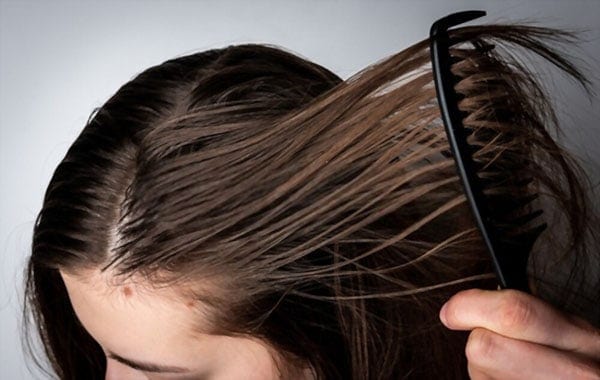The sebaceous glands attached to each hair follicle produce sebum, an oily substance, that travels up the hair follicle to moisturize the skin and hair.
When excessive oil accumulates at the roots of the hair, it gives a greasy or sticky appearance to the hair. However, the quantity of this natural oil differs, influenced by the hair type, hygiene habits, and other lifestyle factors.
Intense exercise sessions, exposure to a humid atmosphere, or overuse of hair products often gives rise to an oily hair day. The extra sebum may cause acne problems, causing dead skin cells to stick together and clog skin pores.
What Are The Ways To Get Rid of Greasy Hair?

A few changes in your daily haircare routine can result in healthy, shiny hair free from extra grease.
1. Avoid putting oil on your scalp
Since the scalp is already producing oil naturally, do not add any other extra oil to the scalp. It may create an oil buildup, and exacerbate the problem, resulting in extra greasiness.
2. Apply apple cider vinegar
The astringent properties of apple cider vinegar help to remove excess oil from the skin. A hair rinse in diluted apple cider vinegar helps to balance the pH of the scalp, maintaining proper oil balance and preventing oil buildup.
Procedure to apply apple cider vinegar – Mix 3 tbsp of apple cider vinegar to 1 cup of warm water. After proper hair washing, apply this diluted apple cider vinegar solution to the hair and scalp. Let it sit for about 5 to 10 minutes.
Then rinse your hair with cold water. Repetitive use of this vinegar solution, 3 to 4 times per week may help you to get rid of greasy hair.
3. Apply conditioner only to the hair and not the scalp
The conditioner is meant only for the hair. It should never be applied to the scalp, as that will result in product buildup, which will, in turn, make your hair oily. So apply conditioner only to the ends of your hair, and rinse it thoroughly.
4. Try a dandruff shampoo
Hair with more oil production is also more likely to be prone to dandruff and greasy flakes. So in such a case, you may use a dandruff shampoo to work into your scalp.
The zinc pyrithione present in anti-dandruff shampoos helps in reducing the oil and dandruff levels. Make sure to apply the dandruff shampoo to your scalp for it to do its job properly.
5. Shampoo properly
Not washing your hair properly may also result in an oily scalp and damaged hair. For proper washing of your hair, gently apply a small amount of organic shampoo to the roots of your hair and scalp.
Never use your nails and avoid creating useless friction on the hair strands. Aggressive scrubbing of the scalp and hair may irritate the scalp, resulting in excessive oil production.
Never apply shampoo directly to the hair ends. Instead, let it flow to the ends as you rinse your hair. Apart from this, too often or too little shampooing may also contribute to greasy hair. For greasy hair, you should shampoo daily.
Shampooing more than once a day may result in excessive oil production to make up for the extra washing.
6. Use a hair dryer
The heat of a blow drier absorbs oil from the scalp and helps to get rid of greasy hair. Dermatologists recommend blow-drying the hair at the root.
It plumps the hair follicles and in turn, absorbs the extra oil. While blow-drying, make sure to use the lowest heat setting to avoid heat damage.
Conclusion
If the greasiness in your hair still persists, it’s probably time to visit your dermatologist and get a full hair evaluation done. A dermatologist will review your treatment options and you can proceed in a way that you feel comfortable.

I’m Natalia, the mind behind HairLossCares.net. I was facing hair fall a few years back. I’m sharing my experience on this blog.
